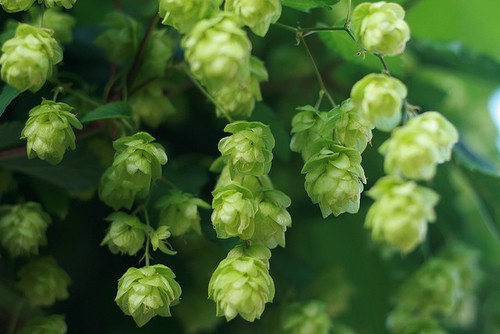Hop-Ed
Contributed by on Aug 24, 2014
Zero readers love this post.
My great-grandmother owned a hops farm in the Newberg area of Oregon. I never had the chance to know her, but my dad told me stories of how he picked hops as a teenager during the late summer harvest. The female flower of the hop plant, a seed cone, is used in brewing beer. These seed cones are very sticky, like pine pitch. My dad would wrap electrical tape around his hands and fingers to prevent the sticky pitch and the roughness of the plant from tearing the skin from his hands and fingers. Even back in the 1940s, most hops were harvested by machine, but small growers like my great-grandmother could only afford to use hand-pickers, the cheap labor of my dad and his cousins.
Beer is nearly 9000 years old. Ancient civilizations that grew grains and ground flour discovered that excess grains, flour, and bread were prone to spoilage between harvests. Turning grain into beer extended the life of the grain. Beer was considered a food; like liquid bread. Hops originally grew wild in different regions of the world. Evidence suggests that some of the first hops plant originated in Romania, Transylvania, and the Moldavia region. Hops were used by Babylonians and Egyptians from 3000-5000 BC as an herb and medicine, but the Romans were the first to use the hop flower in beverages. Hops in beer production was first described in written documents around 736 AD by a Benedictine monk in France.
I learned to brew beer in the early 80s. I worked in Silicon Valley where I became friends with an engineer and active beer brewer. He would invite a couple of us over after work to sample his latest creations. I expressed an interest in the craft so he began to teach me. We experimented with Pale Ale, Stout and Porter, styles of beer that were previously unknown to me. When I wasn’t drinking home brews, I was drinking India Pale Ale from Sierra Nevada, one of the craft brewing pioneers. I discovered that hops made beer bitter, not sweet, and I found I really liked the flavor.
Hops are used in brewing for two purposes: one, to counteract the residual sugary sweetness of the brewing process by adding bittering; and two, to preserve and extend the life of the brewed product. Originally beers were bittered with ingredients called gruits, which contained fruits, spices, and oak products, while ales almost always used hops to bitter, flavor and preserve the drink. Although this was the distinction between beers and ales in the 15th and 16th centuries, it is not true today, as modern beers and ales can both contain hops. Today the main distinction is the type of yeast used in fermentation. Beers (lagers and pilsners) use a bottom fermenting yeast while ales use yeast that ferments on the top of the brew. The other difference between beers and ales is the fermentation temperature. Ales ferment at about 55 degrees Fahrenheit and lagers at 40 degrees or lower. The warmer the temperature the faster the fermentation process.
There are two properties hops add to beer – bitterness and aroma. Bitterness is measured in IBUs (International Bitterness Units), which is determined by the content of alpha acids by volume. The higher the IBU, the more bitterness you can expect to taste. Bittering hops are added at the beginning of the boil while aromatic hops are added later on in the boil, often at numerous times. These aromatics contribute floral, citrus, and herbal flavors to beer. Craft brewers are increasingly seeking out aromatic hops to add new dimensions to their brew. You may come across the term dry hopping – this means adding aromatics after the fermentation process is complete.
In the early 2000s my nephew and his friends, IPA drinkers, tried to outdo one another by finding the most outrageously hopped craft brewed IPAs. This was at the beginning of the Extra IPA revolution that was taking place across America and is still going strong today. Extra, also known as West Coast, IPA requires using a large quantity of specialty hops and five to seven additional brewing steps. Specialty hops are chosen for different properties. Each strain of hops has unique bitterness strengths as well as taste and aroma qualities. It usually takes at least three to four different types of hops to make an Extra.
In 2012 there was a severe hop shortage. Demand by craft brewers, home brewers, and increased production of hoppier beers and ales kept hop supplies, already at a fragile level, severely depleted. The effect of this was that craft breweries could not produce beers and ales that required large amounts of hops, like the Extra IPA. I could not purchase my favorite mega-hopped IPA - Hop Stoopid from Lagunitas. There weren’t enough hops available to produce marketable quantities of this style of beer. Blame was also placed on the world's largest beer brewer, Budweiser, for locking up hops contracts and forcing hop farmers to grow hops of a lower alpha acid content that few craft brewers use.
With the craft brewery explosion, hop demand can only increase. Hops usage in craft brews is about twenty times over corporation brews like Budweiser and Sam Adams. Less than a year ago, a local brewmaster told me West Coast IPAs were a fad, and the fad was over. Today he is brewing double IPAs.
Obviously my great-grandmother was ahead of her time.
Jim St. Germain is president of St. Germain Cellars and the resident hops enthusiast. When he isn't evangelizing IPAs (75+ IBUs!), he enjoys a nice glass of pinot noir or good whiskey, neat.
(Image Credit: Paul Miller/cc 2.0/M)

